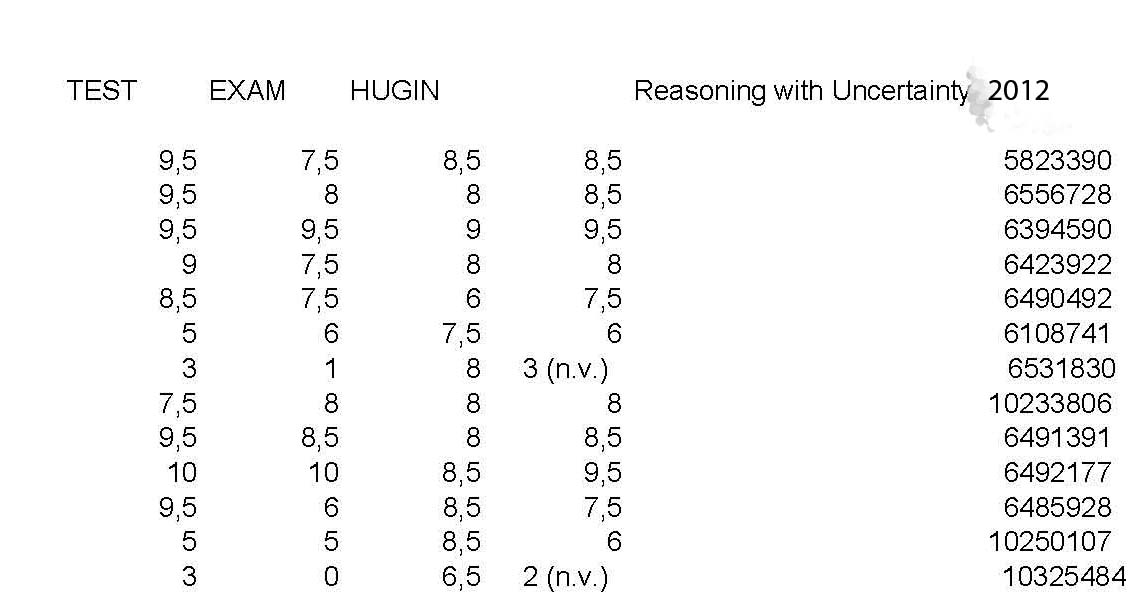Reasoning with Uncertainty
(2nd semester 2011/12)
Lecturer:
PD Dr. Reinhard Blutner
Lectures: Block A: Wednesday 13-15, A1.06 (Science Park); Block B: Wednesday 13-15, G3.13 (Science Park)
Office Hours: by appointment
Outline
Reasoning with uncertainty
and with probabilities is important for many fields of Artificial Intelligence,
especially for expert systems, robotics, and neuronal networks. The course
gives a representative overview of the various models and instruments that deal
with uncertainty and vagueness, such as Bayesian networks, certainty factors, Dempster-Shafer
theory, fuzzy logic, possibilistic logic, and quantum probabilities. The aim of
the course is to look both for practical applications and to provide a basis
that enables us to compare the different formalisms with each other.
Examinations
This course will be graded
based on
Obligatory Homework:
(Questions concerning the
homework can be asked at the beginning of the following lecture)
Hugin exercise:
20%
(Final deadline
for the Hugin exercise: April 4. Grade is
reduced if work is late: -1 per day!)
Test: 30%
(After the first 5
courses which are based on the Halpern book)
Final exam: 50%
Final mark and final exam

Course Material
|
Quantum Logic and
Probability Theory |
|
Hugin Exercises [pdf-file] |
Here you can find the solution for the special homework
4.1.Word meanings and LSA: Perform a SVD for the course example ... [pdf]
Schedule
|
Week |
Content |
Slides |
Exercises |
|
P A R T 1 |
|||
|
1 |
Representing Uncertainty 1 |
ExercisesPart1: 1.3, 1.4, 1.6 |
|
|
2 |
No class on February 15 |
||
|
3 |
Representing Uncertainty 2 |
ExercisesPart1: 1.7, 1.8, 1.10(ii)&(iii),
1.11
|
|
|
4 |
Updating Beliefs |
ExercisesPart1: 2.3. 2.4, 2.5, 2.7 |
|
|
5 |
Bayesian
Networks 1 |
ExercisesPart1: 3.1, 3.2, 3.3, 3.4 |
|
|
6 |
Bayesian Networks
2 / Explaining the Hugin Exercises |
ExercisesPart1: 3.5, 3.6, 3.7 |
|
|
7 |
Rationality: the Dutch Book argument
Test |
ExercisesPart2: 1.2,1.3
Writing the TEST: March 21. |
|
|
P A R T 2 |
|||
|
1 |
Dempster Shafer Theory 1 & 2 |
ExercisesPart2: 2.2, 2.3, 2.5, 2.6, 2.7 Deadline for Hugin exercise! |
|
|
2 |
Fuzzy sets 1 |
ExercisesPart2: 3.1 a&b, 3.3 c&d, 3.5
|
|
|
3 |
Fuzzy sets 2 |
ExercisesPart2: 3.8, 3.10, 3.11 c. | |
|
4 |
Quantum Probabilities 1 |
ExercisesPart2: 4.1 a, 4.2, 4.3 | |
|
5 |
No class on May 2nd |
ExercisesPart2: 4.4, 4.6, 4.7 |
|
|
6 |
Quantum Probabilities 1/2 |
||
|
7 |
Quanten Probabilities 2 |
||
|
8 |
Applications of quantum probabilities |
|
see a recent BBS target paper |
|
|
|
||
Note concerning the origin of Hugin
"During an EU-sponsored research project (under the ESPRIT program) on diagnosing
neuromuscular diseases, the Bayesian network MUNIN was constructed. A research
group at
Related Websites
- Artificial Intelligence: A Modern
Approach by Stuart Russell and Peter Norvig.
- Nicholson’s and Korb’s lecture
- Joseph Y. Halpern
- Association of Uncertainty in AI
- Reasoning with Uncertainty
- Reasoning with Uncertainty in Robot
Navigation
- ATAI area decision and
reasoning under uncertainty
- Hugin
- Journals
Websites for Quantum Cognition
- Diederik Aerts
- Harald Atmanspacher
- Dick. J. Bierman
- Liane Gabora
- Gordon Globus
- Stuart Hameroff
- Samuel Lomonaco
- Jibu Mari (click here for a review of the
Jibu/Yasue book)
- Henry Stapp
- Dominic Widdows
- The quantum brain page
- Quantum Cognition
and some
relevant articles and books:
Aerts, Diederik, Jan Broekaert & Liane
Gabora (2006). A case
for applying an abstracted quantum formalism to cognition. In
Aerts, Diederik, Marek Czachor &
Bart D’Hooghe (2005?). Do We Think and Communicate in
Atmanspacher, Harald, Hartmann Römer
& Harald Walach (2002a). Weak Quantum Theory: Complementarity and
Entanglement in Physics and Beyond. Foundations of Physics 32(3):
379-406.
Gabora, Liane & Dederik Aerts
(2002). Contextalizing concepts using a mathematical generalization of the
quantum formalism. Journal of Experimental and Theoretical Artificial
Intelligence.
Jibu, Mari & Kunio Yasue (1995).
Quantum Brain Dynamics and Consciousness. Amsterdam/Philadelphia: John
Benjamins.
Lomonaco, Samuel J. Jr. (2000). A rosetta
stone for quantum mechanics with an introduction to quantum computation.
Vedral, Vlatko (2006). Introduction
to Quantum Information Science.
Widdows, Dominic & Stanley
Peters (2003). Word Vectors and Quantum Logic: Experiments with negation and
disjunction. Paper presented at the Eighth Mathematics of Language
Conference, Bloomington, Indiana.